

Virtual Screening. The most fundamental goal in the drug design process is to determine whether a given compound will bind to a target protein and if so how strongly.

Rapid developments in the fields of combinatorial chemistry and high-throughput screening (HTS) technologies have enabled large libraries of compounds to be synthesized and screened. However, synthesizing a large number of compounds is expensive and the subsequent screening experiment can still be time-consuming. As a result, computational methods are gaining increasing popularity in drug discovery. Virtual screening (VS) represents a powerful alternative strategy for identifying hit molecules from a set of compounds in a relatively short period of time, which has already become a crucial step in early-stage drug discovery. Biopharmaceutical Process and Product Related Impurities Analysis. Biopharmaceutical products are synthesized by living cells, and hence during the purification process the substrates for growth, host cell components and product variants must be removed.
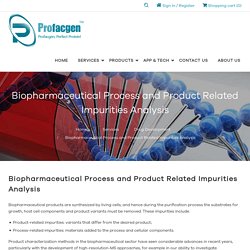
These impurities include: • Product-related impurities: variants that differ from the desired product;• Process-related impurities: materials added to the process and cellular components. Product characterization methods in the biopharmaceutical sector have seen considerable advances in recent years, particularly with the development of high-resolution-MS approaches, for example in our ability to investigate glycosylation of antibodies. The need for advanced characterization is also being driven by the biosimilars market where a company developing a generic product must show to the regulators comparability to the innovator product.
Profacgen offers a wide range of pharmaceutical services which includes biopharmaceutical product related impurities analysis. Stability Analysis Services. Characterizing biopharmaceutical protein stability is critical during all phases of biopharmaceutical development, including candidate selection, preformulation screening and formulation development, process development, and manufacturing support.
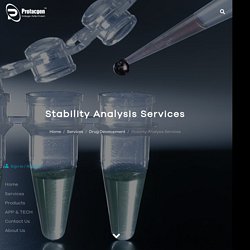
Protein stability and higher order structure is also used to assist with biocomparability studies. Profacgen provides protein stability analysis technologies for the biopharmaceutical industry. There are three major factors affecting protein stability: hydrophobic interactions, hydrogen bonds and conformational entropy. The literature is in general agreement that the two types of interaction that are most prevalent in proteins are (i) hydrophobic interactions and (ii) hydrogen bonds. The reaction of these bonds upon going from the unfolded to the folded state is summarized in the figure below.
Figure 1. Figure 2. GLP Compliant Protein Production. Profacgen is capable of providing professional GLP Compliant Protein Production service to accelerate our customer’s preclinical drug development process.
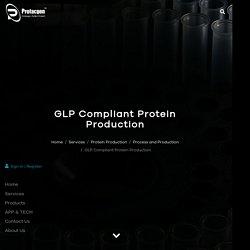
GLP (Good Laboratory Practice) refers to a set of principles that provides a framework for studies that are planned, performed, recorded, reported, archived and monitored. GLP-validated assays and manufacturing services under GLP guidelines help assure regulatory authorities that the data submitted are a true reflection of the results obtained from preclinical study and therefore can be relied upon when making safety assessments. GLP quality standards set up a quality system of management controls for research laboratories and organizations to ensure the consistency, reproducibility, quality and reliability of pharmaceutical and non-clinical safety assays. These standards guarantee the investigation of safe and efficient drug candidates to be undertaken in a harmless and effective way. Cell Line Development for Industrial Manufacturing. Profacgen provides stable cell line development service for industrial protein manufacturing.

We offer various cell line development options, which allow the maximum flexibility in reaching our client’s expectations and accelerate the preclinical drug development process. Stable expression line construction is recommended for reproducible and cost-effective protein production, when large amount of recombinant protein is required. Profacgen guarantees well-developed stable cell lines with robust and reproducible production of the target protein. Stable cell line development is significant for: At Profacgen, we use lentiviral vector for efficient gene delivery and to achieve high integration rate. Features: Feel free to contact us for more details of our Cell Line Development service. ADME/Tox Prediction. The characterization of Absorption, Distribution, Metabolism, and Excretion (also known as ADME) and Toxicity are essential steps in drug development.

ADME describes the disposition of a pharmaceutical compound within an organism, and has been applied in drug discovery to investigate the drug levels and kinetics of drug exposure to the tissues and hence influences the performance and pharmacological activity of the compound as a drug. It covers a lot of different assays investigating parameters such as membrane permeability, metabolic stability and toxicity. Quantum Mechanics/Chemistry in Drug Design. The process of drug discovery involves the identification of molecular candidates, synthesis and test of chemical compounds for their pharmaceutical efficacy.
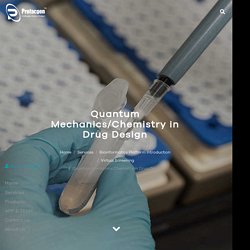
Computer-Aided Drug Design (CADD) is a specialized sub-discipline of rational drug design that uses computational methods to investigate/predict drug-receptor interactions. Quantum mechanics (QM) is an essential tool in CADD research. High-throughput in silico screening of ligand binding (such as docking or QSAR) can significant reduce the time required for compound discovery and optimization. However, these rapid methods often lack the accuracy in exploring the binding mechanism details.
On the contrary, we can obtain a more accurate representation of molecular systems with QM approaches. Profacgen provides QM calculation service to describe the protein system, including ligands and solvent, in order to gain a better understanding of protein-ligand interactions with improved accuracy. Features. 3D-QSAR. The research and development of therapeutic drugs is an expensive and time-consuming process.
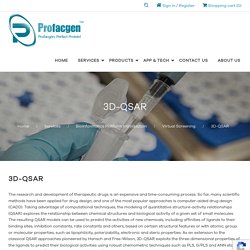
So far, many scientific methods have been applied for drug design, and one of the most popular approaches is computer-aided drug design (CADD). Taking advantage of computational techniques, the modeling of quantitative structure-activity relationships (QSAR) explores the relationship between chemical structures and biological activity of a given set of small molecules. The resulting QSAR models can be used to predict the activities of new chemicals, including affinities of ligands to their binding sites, inhibition constants, rate constants and others, based on certain structural features or with atomic, group or molecular properties, such as lipophilicity, polarizability, electronic and steric properties.
Structure- and Ligand-Based 3D QSAR Protocol Features. CLIP-Seq Service. Post-transcriptional regulation contributes to the ability of cells to modify gene expression when facing changing external or internal environment.
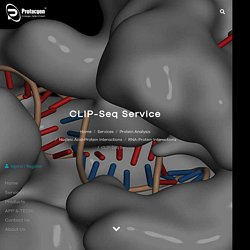
RNA-binding proteins (RBPs) are key players in the post-transcriptional regulation of gene expression. CLIP (cross-linking immunoprecipitation) is a method used to analyze RNA-protein interactions or locate precise RNA modifications. Yeast Two-Hybrid Screening. Specific interactions between proteins form the basis of most biological processes, thus the knowledge of an organism’s protein interaction network provides insights into the function(s) of individual proteins, the structure of functional complexes, and eventually, the organization of the whole cell.

The Protein-protein interactions (PPIs) can be detected by plenty of experimental methods. However, the yeast two-hybrid system (Y2H) is the most popular method to identify binary PPIs in vivo (Figure 1). Figure 1 Yeast two-hybrid principle A protein of interest ‘B’ is expressed in yeast as a fusion to a Gal4p DNA-binding domain (DBD, “bait”; circles denote expression plasmids). Bio-Layer Interferometry (BLI) Service. Profacgen provides a comprehensive panel of services for the study of protein-protein interactions, of which the Bio-layer Interferometry (BLI) analysis is commonly used by our customers for the quantitative and qualitative characterization of biomolecule interactions and other applications. The BLI biosensor platform, developed by ForteBio, is a label-free detection system for molecular interaction analysis, based on the principles of optical interferometry.
In this system, the interaction occurs at the very tip of a glass fiber-based BLI biosensor. White light travels down the glass fiber and is reflected back up from two interfaces at the tip: internal interface and external interface. When molecules bind to the surface of the biosensor, the thickness variation of the external layer of immobilized protein causes a shift of the interference pattern. Screening and Profiling Services. As a global leader of drug screening and profiling services, Profacgen offers a comprehensive panel of services designed to speed and simplify your drug discovery research. Our biochemical and cell-based screening services are considered excellent tools to quickly narrow down a large pool of candidates to a much smaller one, to identify potential therapeutics and to predict potency. Choose the right service for your purpose:Enzyme Target & Activator & Inhibitor Screening ServiceGPCR Screening ServiceIon Channel Screening ServiceTransporter Screening Service With all screening and profiling services, profacgen will provide you comprehensive report with method, reagent, detailed protocol and analyzed data.
Most of the key reagents used in above services are developed by ourselves, and assay protocols were validated thoroughly. Enzyme Target & Activator & Inhibitor Screening Service. Profacgen offers a comprehensive list of high-throughput screening services to specifically and efficiently identify potential enzyme substrates, activators and inhibitors. Enzymes participate in numerous physiological activities including signal transduction, cell surface recognition and protein modification. To determine possible targets of an enzyme, Profacgen has developed a highly efficient screening system to select candidate substrates, inhibitors or activators by detection of fluorescence, chemo-luminescence or isotopic signal.
Generally, the candidate molecules can be selected or synthesized and then immobilized on a solid surface. Detection is performed after incubation with the target enzyme according to the specific experimental design. Profacgen provides enzyme target screening service for kinase, phosphatase, protease, methyltransferase, glycosyltransferase, acetyltransferase and so on. GPCR Screening Service. Profacgen offers professional high-throughput GPCR screening service for the identification of potential GPCR-targeting drugs. G protein-coupled receptors (GPCRs) are also known as seven-transmembrane domain receptors. They are only found in eukaryotes. Because of their extensive involvement in cell signal transduction, GPCRs have become important drug targets. Nearly 40% of modern drugs are GPCR-targeted, and 20% of top the 50 best-selling drugs are GPCR related.
Ion Channel Screening Service. Schematic Diagram of an Ion Channel Ion channels are pore-forming proteins that are embedded in the membranes of all living organisms, responsible for extracellular and intracellular electrical signaling. As electrical signaling is vital for many physiological activities, ion channel becomes an important target for novel drug development. Profacgen provides professional ion channel screening service to identify possible hits for a given ion channel, and offers ion channel cell model development service. Hundreds of different types of ion channels have been discovered. Protein Structure Modeling. The three-dimensional structure of a protein provides essential information about its biological function and facilitates the design of therapeutic drugs that specifically bind to the protein target.
Recent years have witnessed a tremendous increase in the number of experimentally determined protein structures. Homology Modeling. The three-dimensional structure of a protein is essential to the understanding of its biological function and the design of drug candidates. In recent years, tremendous progress has been achieved in structural biology and a large of number of new macromolecular structures have been determined using experimental methods such as X-ray crystallography, NMR and cryo-EM. Despite the impressive advances, it is still generally difficult and time-consuming to obtain structures for every protein of interest. This is why computational approaches come into play as a powerful alternative and supplement to experimental methods. Homology modeling (also known as comparative modeling) is, to date, the most reliable and well-established computational approach for predicting protein structures. Membrane Protein Modeling.
Large-Scale Protein Production. Large-scale recombinant protein production is becoming increasingly important for applications in the field of proteomics, structural biology and protein therapeutics. When large quantities of protein (from mg to g amounts) needs to be produced from either bacterial (e.g. Escherichia coli) or eukaryotic cell-based culture (e.g. yeast, insect and mammalian cell), cells must be cultured in large volume by the implementation of fermentation techniques. Custom Lysate Preparation Service. Profacgen provides custom lysate preparation service to meet your scientific requirements for downstream analysis.
We provide various types of lysates including over-expression lysate, tissue lysate, cell line lysate, stem cell lysate and membrane lysate, reaching to more than 15, 000 kinds of lysate available. We actually have many lysate products already available in stock from human, cynomolgus monkey, bovine, canine, ferret, mouse, rat, rabbit, zebrafish, guinea pig and so on. Our high-quality cell/tissue lysate can be used in SDS-PAGE, western blot, ELISA, co-immunoprecipitation, pull down assay, tissue specific expression identification and many other bio-analytical assays, and can be applied in various research fields such as biological and pharmaceutical studies. Yeast Two-Hybrid Screening. Protein Interaction Analysis Services. Protein-protein interactions (PPIs) are established when protein molecules physically contact with each other through hydrogen or hydrophobic bonds, Van der Waals forces, ionic forces, or even covalent bonds.
This phenomenon underlies a wide range of essential cellular events such as signal transduction, molecular transport and various metabolism pathways. PPIs are also the basic of many diseases. Therefore, PPIs have been studied extensively in the area of bioscience and medical research. Profacgen has organized a team of scientists with extensive experience in the study of PPIs to offer you one-stop service on your PPI project. Protein Mutagenesis. Protein Mutant Library Construction. Custom Lysate Preparation Service. Stable Cell Line Construction for Protein Expression. Protein–Peptide Docking.
Protein–Protein Docking. Protein–Nucleic Acid Docking. Protein–Ligand Docking. Molecular Docking. Fold Recognition. Post-translational Modification. Fusion Protein Modeling. Surface plasmon resonance (SPR) Service. Membrane-based Yeast Two-Hybrid Screening. Yeast Two-Hybrid Screening. Protein Interaction Analysis Services. Protein Mutagenesis. Protein Mutant Library Construction. Stable Cell Line Construction for Protein Expression. Custom Lysate Preparation Service. Protein Conjugation Service on Beads. Nicotiana tabacum Expression System. Mammalian Cell Expression. Bacteria Expression. Yeast Expression. PEGylation Products and Services. Protein Conjugation Service on Beads.
Protein Biotinylation Service. Quantum Dot Labeling. Large-scale Protein Production. Stable Cell Line Construction for Protein Expression. Custom Lysate Preparation Service. Protein Mutant Library Construction. Protein Mutagenesis. Yeast Two-Hybrid Screening. Surface plasmon resonance (SPR) Service. Membrane-based Yeast Two-Hybrid Screening - Profacgen. Co-Immunoprecipitation (Co-IP) Yeast Two-Hybrid Screening - Profacgen. Protein Interaction Analysis Services - Profacgen.